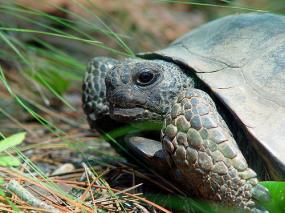Executive Summary

There is much to be learned from Lonesome George. Perhaps the most critical lesson is that we must engage in conservation activities prior to a species becoming critically endangered if we want to help ensure its survival. Acting late is risky and expensive; but individuals respond to incentives and require a carrot or a stick to act early to conserve species.
The federal framework for species conservation in the United States—the Endangered Species Act (ESA)—is often characterized as a reactive tool. A system of positive incentives for environmental stewardship upstream of listing under the ESA could enhance the nation’s framework for species conservation by motivating proactive species management and removing perverse incentives for landowners.
Consider species like the gopher tortoise, the greater sage grouse, and the lesser prairie chicken. These species are considered by the USFWS to be biologically imperiled to the point of needing ESA protections. In at least parts of their ranges, however, the USFWS is precluded from listing these species under the ESA due to higher priority actions and agency funding constraints. Until resources are available to initiate a formal listing, these species wait on the “Candidate” list. Waiting on this list equates to regulatory limbo—the species are biologically threatened or endangered, yet receive no legal protection at the federal level.
The incentive-based approach to pre-listing conservation is commonly referred to as “advance mitigation” or “candidate conservation banking.” By aligning the interests of project developers, private landowners, conservation advocates, and the USFWS, this approach can complement and improve the performance of existing ESA programs by mobilizing actions that achieve net conservation benefits for at-risk species before they are listed.
This paper offers a summary of the three generations of the Endangered Species Act followed by a discussion of the benefits and hurdles of pre-listing conservation strategies—primarily in the form of pre-listing conservation banking. The incentive-based approach for the conservation of candidate species is highlighted by a brief case study on the eastern population of the gopher tortoise. Specifically, pilot partners are working with the U.S. military, which is trying to proactively manage gopher tortoise habitats before federal listing under the ESA becomes necessary and potentially leads to a loss of training capacity on bases. The paper then suggests that this model can be replicated in other parts of the United States dealing with candidate species such as the lesser prairie chicken and greater sage grouse.


